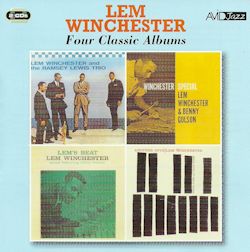CD1
A Tribute To Clifford Brown
1. Joy Spring
2. Where It Is
3. Sandu
4. Once In A While
5. Jordu
6. It Could Happen To You
7. Easy To Love
8. A Message From Boysie
Lem Winchester – Vibes
Ramsey Lewis – Piano
Eldee Young – Bass
Isaac “Redd” Holt – Drums
Winchester Special
9. Down Fuzz
10. If I Were A Bell
11. Will You Still Be Mine?
12. Mysticism
13. How Are Things In Glocca Morra?
14. The Dude
Lem Winchester – Vibes
Benny Golson – Tenor sax (tracks 9-13)
Tommy Flanagan – Piano
Wendell Marshall – Bass
Art Taylor - Drums
CD2
Lem’s Beat
1. Eddy’s Dilemma
2. Lem And Aid
3. Friendly Persuasion
4. Your Last Chance
5. Lady Day
6. Just Friends
Lem Winchester – Vibes
Curtis Peagler - alto sax
Oliver Nelson – Tenor sax
Roy Johnson - Piano (tracks 1, 4)
Billy Brown - Piano (track 5)
Wendell Marshall - Bass
Art Taylor - Drums
Another Opus
7. Another Opus
8. Blues Prayer
9. The Meetin’
10. Like Someone In Love
11. Both Barrels
Lem Winchester – Vibes
Frank Wess – Flute
Hank Jones – Piano
Eddie Jones – Bass
Gus Johnson – Drums
Lem Winchester’s career is basically a sad and surprising story. The vibes-player’s first album was privately recorded in 1957 but someone sent a copy of
it to Leonard Feather. Leonard invited Lem Winchester to appear at the 1958 Newport Jazz Festival, where Lem’s success persuaded record companies to sign
him up for more discs. And that success eventually convinced Lem to give up his career as a police officer and go professional full-time as a musician. He
swiftly recorded about a dozen albums but he was killed on 13 January 1961 while performing a trick with a handgun.
Lem Winchester was highly lauded after his appearance at Newport but these four albums make me wonder if the praise was entirely justified. Lem’s technique
on vibes might be compared to that of Milt Jackson but he is nowhere near as fluent as Milt. On several tracks he sounds uncertain and he often plays wrong
notes or pauses worryingly as if he doesn’t know what to do next.
The first LP in this compilation of four, A Tribute To Clifford Brown, is a homage to a close friend of Lem’s from his high school days.
Unfortunately in Clifford’s Joy Spring, Lem fluffs a few notes while stating the theme - a bad start. The same thing happens in Jordu. In Sandu he uses a repetitive single-note technique which reappears later in this double album. Easy To Love also contains uncertainties.
The accompanying Ramsey Lewis Trio holds the session together.
Winchester Special
from 1959 features tenorist Benny Golson and pianist Tommy Flanagan. Lem seems more relaxed on this session and hence seems to make fewer mistakes than
before. Golson and Flanagan contribute excellent solos. Lem is in danger of getting lost in the up-tempo Will You Still Be Mine? But the track
gives drummer Art Taylor the chance for some flamboyant fours.
For Lem’s Beat, an LP from April 1960, Oliver Nelson not only played tenor sax but wrote all the arrangements, which gives the session some extra
class. Nelson also composed three of the tunes. In the first of these, Eddy’s Dilemma, Winchester plays almost a whole chorus on one note. This
may have been deliberate, as he gradually brings in other notes as harmony, but it sounds amateurish. The Oliver Nelson touch is particularly noticeable in
the subtle arrangement of Dimitri Tiomkin’s theme song from the film Friendly Persuasion. Lem’s solo is quite delicate and he is only soloist on
the track. However, in Just Friends he seems to falter in the theme statement. Pianists are only credited as playing on tracks 1, 4 and 5, so who
is the pianist on tracks 2 and 3?
Another Opus
is from June 1960, and this one rings the changes neatly by importing flautist Frank Wess, whose skilful playing makes a nice contrast with the vibes – and
with Hank Jones’ dependable piano. Lem wrote three of the tunes here, to which are added Oliver Nelson’s The Meetin’ and the jazz standard Like Someone In Love. The title-track is an easy-going blues, where Winchester sounds more confident than elsewhere. Blues Prayer is a
very slow blues which seems to hark back to Lem’s liking for the same note repeated almost to exhaustion. The Meetin’ shows up some of Lem’s
weaknesses again, with pauses which seem out-of-context. I think this was Lem Winchester’s penultimate album. Given the tragic events which were to take
place only a few months later, the title of the last tune is unfortunate but Lem copes well with the fast tempo.
Listening to the playback of a track from Lem’s Beat, Winchester said “This is the best session I have made so far…I feel that I am finally in the
first stages of joining the professionals”. I regret to say it but Leonard Feather’s invitation to Winchester to appear at Newport encouraged Lem to try
running before he could walk. He was not such a hugely talented artist as many critics seemed to believe, but someone who was still making the difficult
transition from amateur status. Despite its drawbacks, this double album is a good way of getting nearly half of Lem Winchester’s recorded output in one
handy place.
Tony Augarde
www.augardebooks.co.uk
